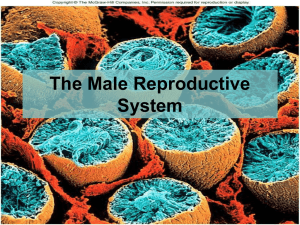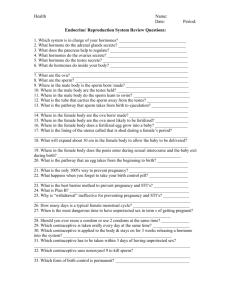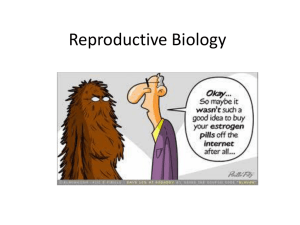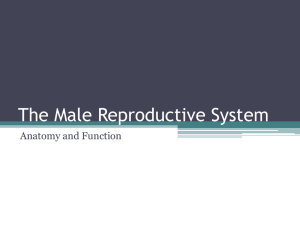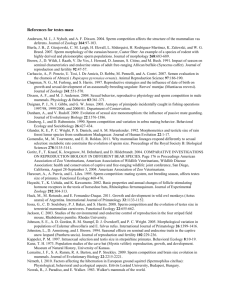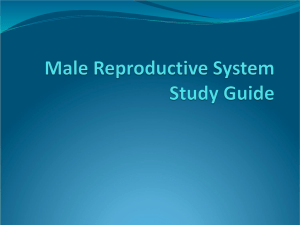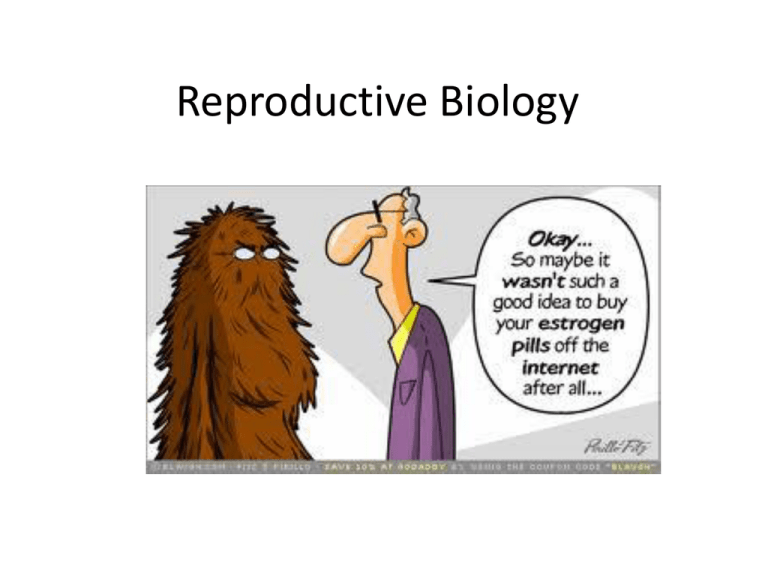
Reproductive Biology
I. Need for Meiosis
• A. Human
chromosome
number = 46
• B. Mitosis
• C. Meiosis
• 1. purpose
• 2. location
• 3. difference in male
and female meiosis
II. Male parts
• A. Scrotum-an air conditioner
– 1. homologous to the female
labia majora
– 2. sac surrounded covered by
skin and layer of smooth muscle
called the dartos muscle
– 3. cremaster muscles (extension
of abdominal muscle) are also
attached to the scrotum
– 4. ideal temperature for sperm
production is 95 degrees
– 5. dependent upon temperatures
these two muscles either contract
or relax pulling testes closer to
the body
B. Testes
• 1. produces sperm
in seminiferous
tubule
• 2. approximately
700 feet long
• 3. site of male
meiosis
• 4. interstitial cells
also located in testes
• 5. producers of
testosterone
6. Descent of the testicles
• a. Testes develop in the
abdomen
• b. Connected by a muscle
called the gubernaculum to
developing scrotum
• c. The gubernaculum extends
from the developing scrotum to
the testes through the inguinal
canal
• d. Around 7-9 months of
development, the
gubernaculum pulls the testes
down through the inguinal
canal into the scrotum
• e. cryptorchidism
7. Spermatogenesis
•
•
•
•
•
•
•
a. Spermatogonia
b. Primary spermatocytes
c. Secondary spermatocytes
d. Spermatids
e. Spermiogenesis
f. Sperm cell
g. Sustentaculuar cell or Sertoli
cell (nurse cell)
• h. Blood-testis barrier
8. Sperm cell
•
•
•
•
•
a. Head
b. Acrosome
c. Midpiece
d. Tail
e.
http://www.youtube.com/w
atch?v=7kM_kRPrcrk
9. Defective sperm and numbers
a.
b.
c.
d.
e.
f.
Defective morphology
Low sperm count
10 million/ml
Varicocoel
Cryptochordism
Retrograde ejaculation
C. Epididymis
•
•
•
•
1. location
2. Head, body, tail
2. 20 feet
3. twenty days to pass
through
• 4. undergo maturation
• 5. storage organ
• 6. contracts upon
ejaculation sending
sperm on to next part
of journey
D. Vas deferens or ductus deferens
1. Travels from epididymis to
urethra
2. Travels through the
inguinal canal with the
spermatic cord-blood
vessels and nerves
3. Expands into the ampulla
4. Then enters ejaculatory
duct
5. Pseudostratified
epithelium
6. Peristaltic contractions
move sperm along
7. Vasectomy
a. Part of vas lies in
scrotum
b. Local
c. Small incision
d. Cuts and ligates
e. Sterile but not
impotent
E. Urethra
1. Prostatic urethra
2. Membranous urethra
3. Spongy or penile
urethra
4. Carries both sperm
and urine
5. Never at same time
6. Stratified columnar
most of length
7. Transitional at bladder
end and stratified
squamous at penile
opening
F. Accessory glands producing semen
1. seminal vesicles
a. Produce 60% of
semen
b. Thick yellowish
secretion
c. Rich in sugar, vitamin
C, prostaglandins, and
fibrinogen
d. Nourish and activate
sperm
e. Joins vas deferens on
either side to form
ejaculatory duct
2. Prostate gland
a. Doughnut shaped
b. Size of peach pit
c. Milky alkaline fluid
that activates sperm
d. Approximately 30% of
semen
e. Anterior to rectum is
able to be palpated by
digital exam
f. Fibrinolysin
g. Hypertrophy
3. Bulbourethral glands
a. Also called Cowper’s
glands
b. Base of prostate-size of
peas
c. First to empty with
ejaculation
d. Cleanse and neutralizes
penile urethra
e. Also minor lubricant for
coitus
4. Seminal fluid
a.
b.
c.
d.
e.
f.
g.
Mature sperm are streamlined missiles
Need nutrient source-fructose from seminal vesicle
Need buffer from prostate
Prostaglandins cause smooth muscle to contract
Fibrinogen and profibrinolysin
Inhibitors of female immune system
Dilutes sperm
G. Penis
a.
b.
c.
d.
e.
f.
g.
Corpora cavernosa
Corpus spongiosum
Urethra
Glans penis
Prepuce
Circumcision
Mechanics of an erection
III. Male hormone regulation
• A. Gonadotropin releasing hormone
– 1. hypothalamus
– 2. controls release of hormones from anterior
pituitary.
B. Anterior pituitary hormones (sounds like female
hormones)
1. FSH -binds to sustentaculuar cells
2. LH (ICSH)-binds to interstitial cells
C. Testosterone production
1.
2.
3.
4.
5.
6.
7.
8.
Interstitial cells of Leydig
In response to LH production by the
anterior pituitary
Occurs at about the age of 12
Maturation of male reproductive
parts
Stimulates production of sperm
along with FSH
Produces male secondary sexual
traits such as hair growth patterns,
deepening of the voice, skeletal
muscle development, increase in
metabolic rate
Targets cells with testosterone
receptors
Some brain cells convert
testosterone to estrogen governing
some male sexual behaviors
Testosterone and Progesterone
D. Inhibin
• 1. produced by
sustentacular cells
• 2. inhibits
hormones
produced by FSH
production
• 3. possible
pharmaceutical
functions
IV. Female parts
A. Ovary
1. primary follicle-huge
number-arrested at prophase I
2. ovarian follicles
3. oocyte and follicular cells
4. antrum with follicular
fluid
5. Graafian follicle
6. ovulation-secondary
oocyte arrested at metaphase
II
7. corpus luteum
8. corpus albicans
Follicle development
Ovulation
• http://www.youtube.com/watch?v=nLmg4wS
HdxQ
• Ovarian slide
• http://medsci.indiana.edu/a215/virtualscope/
docs/chap11_3.htm
B. Duct system
1. Fallopian tubes
2. Fimbriae
3. Uterus
a. Body, fundus, cervix
b. Endometrium, myometrium
c.
http://medsci.indiana.edu/a215/vi
rtualscope/docs/chap11_4.htm
4. Vagina-birth canal
C. Female external genitalia
1.
2.
3.
4.
5.
6.
Mons pubis
Labia majora
Labia minora
Vestibule
Clitoris
Perineum
V. Female physiology
• A. Hormones involved
•
1. Pituitary
•
a . FSH
•
b. LH
•
2. Ovarian hormones
•
a. Estrogen-proliferation of endometrium,
increases sensitivity of myometrium to stimuli,
increases production of progesterone receptors
•
b. Progesterone- endometrial hypertrophy,
relaxes myometrium
B. Timing of typical 28 day cycle
•
•
•
•
1.
2.
3.
3.
menses phase (days 1-4)
proliferative phase or follicular phase (days 5-14)-most variable
ovulation (day 15)
luteal phase or secretory phase (days 15-28)-typically lasts 14 days
C. Endometrial changes
1. Proliferative phase
a. Epithelial cells
proliferate
b. Form tubular
spiral glands
2. Secretory phase
a. Epithelial cells
hypertrophy
b. Glands become
more spiraled and
thicker
3. Day 21 is optimum
for implantation
D. Ovarian events in review
Isolated forgotten terms
•
•
•
•
•
•
•
Menarche
hCG
Capacitation
Amenorrhea
Ectopic pregnancy
Menopause
Climacteric-perimenopause
And then there was baby
• http://www.evtv1.com/player.aspx?itemnum=
735
Fetal development
• http://www.youtube.com/watch?v=RS1ti23SU
Sw

